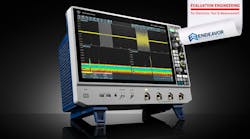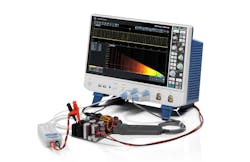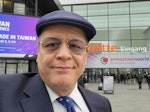Advanced Oscilloscopes Address Next-Gen Design Issues
This article appeared in Evaluation Engineering and has been published here with permission.
What you'll learn:
- Design challenges facing engineers today.
- An insider's look at the R&S RTO6 6-GHz class oscilloscope.
- How the instruments helps address those engineering challenges.
Designing the latest advanced products is getting more and more challenging, with many factors contributing to the difficulties. From advanced core technologies disrupting the marketplace, to the implementation and deployment of those technologies in an effective and optimum manner, having the right test and evaluation tools are an important part of the job.
The latest benchtop engineering tools are getting more and more powerful to address the constantly increasing demands placed upon them. One example can be found in Rohde & Schwarz’s latest product introduction, the R&S RTO6 6-GHz-class oscilloscope. Offering six different bandwidth models from 600 MHz to 6 GHz, with a sample rate of up to 20 Gsamples/s, the fully integrated test solution features a high waveform update rate, excellent signal fidelity, a powerful digital trigger, and responsive deep memory (see figure).
Features include a 15.6-in. full HD screen, an easy-to-use touch functionality, and a redesigned front panel to enable test engineers to quickly set up measurements. The larger screen can display a maximized waveform viewing area, and signals can be dragged and dropped to different parts of the screen with R&S SmartGrid, with access to all of the oscilloscope's applications via a single tap.
An architecture with a dedicated ASIC for optimized signal processing delivers an acquisition rate of up to one million waveforms per second, and a low-noise front end and single-core analog-to-digital converters (ADCs) with extremely small linearity errors offer a spurious-free dynamic range (SFDR) of 65 dBc, and a 9.4 ENOB. A high-definition mode increases the vertical resolution of the R&S RTO6 oscilloscopes up to 16 bits with digital filtering, also used by the digital trigger system that gives the R&S RTO6 the capability to isolate even the smallest signal details.
More than 90 measurement functions are included in the R&S RTO6 series, organized into amplitude and time measurements, jitter, eye, histogram and spectral measurements. The R&S RTO6 is now available from Rohde & Schwarz as a four-channel base instrument with bandwidth options of 600 MHz, 1 GHz, 2 GHz, 3 GHz, 4 GHz, and 6 GHz. We caught up with Tim Paasch-Colberg, product manager for the RTO6 family, to get a handle on some of the important aspects of the new series.
EE: It’s amazing how oscilloscopes have come so far. Once upon a time, an oscilloscope could do only one basic thing, and that was display and capture information. So why don't you tell me a little bit about how you see the migration of the oscilloscope into the tool that is today?
Tim Paasch-Colberg: Well, back in the day, a scope was a tool where you would measure a signal varying over time, and could display that when it was still analog. Several years ago, digital oscilloscopes became available, and they are initially running on computers. Well, once a signal gets digitized, you can do much more than just display the signal over time. Of course you can still analyze relatively simple analog signals, and just voltage and/or current over time, but now you can do logic analysis, you can do protocol, you can do compliance tests. For example, you can measure the communication interface of your DUT and check if it's compliant with the standard you're using, or not.
The RTO, for example, has very powerful spectrum analysis built in. So with this scope, you basically also get a dedicated spectrum analyzer, but it's already sufficient for many, many applications. Therefore, I think spectrum analysis with today's oscilloscopes is a very broad field of application now. Also, when it comes to power electronics testing, you need oscilloscopes for that. And it depends on what you actually want to measure. In some cases you would also need the signal over time and do analysis on that. In some cases you would also use spectrum analysis, because for example, if you want to do EMI debugging, you typically also look at the spectrum part of your signal.
EE: Today's designer has to have a multi-tool available, because otherwise they would not be able to address all of the moving parts into these designs. So to have a tool that does everything reasonably well is far more valuable to the developer than a vertical device that is precise to three figures. The importance here is the power it's bringing to the average benchtop. I'd like to hear what your thoughts are on that aspect of it, about bringing that functionality, that level of performance that was previously inaccessible, to that price point.
Paasch-Colberg: It's a good point you're mentioning here. When looking at the EMI part, for example, every electronic device that goes on the market has to fulfill EMI standards. For that, it typically has to go to a test house where they have all this super-expensive equipment to run this EMI test. But the developer who is building a device, at some point before he or she has to run the EMI test in the test house, they can easily use an oscilloscope to already do some EMI debugging, to find out where sources of interference and EMI or emissions are on the board.
Now all of this initial finding of sources and so on, and learning about their power-off emission, can easily be done with a relatively cheap oscilloscope. So at the end, for them, it's critical to be fast on the market for a relatively reasonable amount of money, and this scope is exactly what helps them there. Especially if you have an oscilloscope with a very rich toolbox, like the RTO6, for example.
EE: We've talked about the migration of the oscilloscope and how it's become a powerful tool. So now I'd like you to talk about how this represents that trend.
Paasch-Colberg: The RTO6 has a very, very broad toolbox for different applications. So it's not just the voltage over time measurement tool, it's much more than that. Like I mentioned earlier, we have logic analysis in there, we have protocol analysis, we have compliance tests in there. We have very powerful spectrum analysis, with power and analysis options. And on top of that, we have things that you would need for very high-speed interface testing.
In some cases, you need de-embedding, which means you basically compensate for the effect of your measurement chain. So this scope can, in real-time, compensate for your setup, your cables, all the connectors, and so on. It has time-domain reflectometry, time-domain transmission, and an atlas is built in. And with this, you can analyze traces on your board.
With everything getting faster, and signals getting quicker, and lanes on your board getting smaller, it really matters how long they are, compared to other traces. So you need to analyze all that on your board. On top of that, the RTO has jitter analysis built-in. With everything going digital and going faster and faster, jitter is becoming a very important topic.
EE: Well, the more powerful the circuits, and the more powerful the systems, you've got to be faster than that, because in order to measure something, you have to be more precise than what you're measuring.
Paasch-Colberg: That's right, you can only get the signal as precisely as your measurement device can measure. And we addressed this topic with the RTO oscilloscope in general. We started this journey 11 years ago with this first scope, and already the RTO class oscilloscope had extremely good signal integrity. Over the years, we launched the second generation, which is the RTO2000, which is still in the market, and already had some improvements regarding signal integrity and some other things as well. And now the RTO6 is the third generation of RTO oscilloscopes, and it's getting better over the years.
One thing that is important for oscilloscopes is how fast you can measure. So, of course, the bandwidth is telling you how fast your signal can get, and you can still resolve it. But another very critical topic is how fast you can acquire that signal, and then the next signal. So let's say you take one trace off your signal now. Now the question is, how long does it take the oscilloscope to measure the next trace, that waveform? So, let's say you have a sine wave and it's from the left to right, how often does it fit on your screen? Now the question is, how long does it take before you can capture the next waveform?
This translates into the update rate of the scope, the refresh or acquisition rate, however you call that, it's all the same. The RTO6 reaches up to 1 million waveforms per second. It's extremely fast. This is one of the major points of the RTO, that it's very, very fast. So how does that help the customer?
Let's say they have a signal, and the signal is basically always the same, or very, very similar, like in a communication protocol, for example. But it has a glitch every other time it comes. But you don't know how often. Is it once per second? Is it once every 10 seconds? Is it maybe 10 times per second, or even more than that? Well, if you want to find that out, you would typically run a mask test. If it's a repetitive signal, you can put your mask anywhere, and that the mask is not violated, as long as your signal is correct.
Now, you can run this mask test for a certain amount of time to have some statistics. Let's say you want to record 10 million waveforms. So what does it mean? If you have an oscilloscope that's running very, very slow, with a slow update rate, you need to run this test very long until you have these 10 million waveforms. In contrast, if you have an oscilloscope that runs much faster, you would need to run the test much slower, yeah. This is simple math.
If you have a fast scope, you can measure more waveforms. This, in return, gives you more statistics. I talked about the signal fault that you want to find, and how often it appears. Now, let's say you measure a higher number of waveforms, and with the better statistics you have the much better you learn, how often does my signal interfere or violate with this mask test? That's one very critical thing for an oscilloscope nowadays is how fast can they run these types of tests. Because these tests are getting much, much more important when it comes to communication and interface testing.
Another thing is basically the overall signal integrity. What is signal integrity? To me, when I started with oscilloscopes that's some buzzword. I thought, "Okay. What does it actually mean?" I think it really depends who you're talking to, and everybody says something else. So, I can just tell you what it means to me. To be honest, I didn't look up if there's an official definition for signal integrity. However, to me, signal integrity means when I have a signal and I measure this with an oscilloscope, and I use the oscilloscope to display this sort of signal. How accurate is this representation of the signal on using my oscilloscope compared to the original signal? Now, that's my interpretation of what signal integrity actually means.
EE: One can be over-precise and say, "The extent to the clarity of capture." You want to capture 100% of the signal. And if you successfully capture 100% of the signal, you have 100% signal integrity. So it's just saying the same thing in different words.
Paasch-Colberg: Absolutely. I think engineers or users of oscilloscopes like numbers. They like numbers a lot, and in principle, you can shout out some numbers when it comes to signal integrity. We have things like noise levels. Noise levels of course are important. Well, there's going to be a certain baseline noise in any system. You try to reduce it as much as humanly possible.
Probes are important as well. But you can also just look at the shielding between channels, so you don't have noise coming from one channel to the next channel. On the other hand, you have to use very high-quality components that have inherently lower noise levels now. That's like moving from the city to the countryside where there are no cars. There are many ways to reduce noise.
With the RTO instruments, and especially now with the RTO6, we have a design with low-noise components on the front end. With this, we can achieve very good signal integrity. When you have components in the front end that are noisy, and you send that to your DAC, it basically digitizes the noise. And this is some trash in your signal that you actually don't want. It's like sitting in your flat, and you cannot filter out the noise from the street to listen to your music.
The front-end components are one important part for the signal integrity, but also the analog-to-digital conversion itself. With the RTO6, we have a very good ADC and very good ADC components inside that have a very, very wide spurious-free dynamic range. So when it comes to ADC technology, it's a very broad field on its own. I don't want to go too deep into that, but in principle, there are many ways to digitize signals. And while you do that, you have to take care of a large number of effects. Linearity matters. Then you have distortion effects.
You have gain errors, you have offset errors, linearity errors. Then there are ADCs that have multiple cores to achieve higher bit-depth in principle. But when you do that, you have timing errors, which lead to a reduction of your signal quality. However, with the RTO or the RTO6, we have a very high-end ADC in the system. From our point of view, the one numerical value is the effective number of bits, or the ENOB. With the RTO6, we reach an ENOB of up to 9.4.
If you look at the datasheet values of oscilloscopes, you will find its bit depth. For example, the ADC of the RTO6 is an 8-bit ADC. If you look at other scopes, they have nowadays either 10 or 12 bits. So you might say, well, but this is bad, the RTO has only eight bits, and this other scope has 10 or even 12 bits. What we want to communicate and to get to our friends and customers is that the bit depth of the ADC is just one number in the datasheet of the overall scope.
In principle, they need to look at the overall signal integrity, which is measured with the ENOB. The ENOB in itself is super-complex, but in the end, from our point of view, it's the best value to compare oscilloscopes to each other. If you look at that with the RTO6, we reach an extent and outstanding ENOB of up to 9.4. ENOB on the other hand is very dependent on what bandwidth you have, what vertical settings you have, what input frequency you have, and also to measure ENOB, different people use different methods, and sometimes it's a bit unclear or also questionable.
However, we are very open with the way we measure ENOB, and with this 8-bit ADC, we reached ENOB of up to 9.4. So you might ask how's that even possible? The answer is the digital nature of this oscilloscope, we can use very clever filtering techniques that increase the vertical resolution of the scope and reach this overall system bit depth of 9.4 ENOB. So even with other scopes that have 10-bit or 12-bit ADCs, they do not reach a higher overall system ENOB.
EE: Excellent. Do you have a final thought for our audience about the device?
Paasch-Colberg: Well, we talked a lot about update rates and signal integrity. I think those are basically the most important things that we want to highlight with the RTO6 oscilloscope. In principle, what we really think about the RTO, since the story started 11 years ago, there's a lot of customer input that we learned from. Over the years and due to this, we were able to make this oscilloscope even better than the two generations before. So we really think that in oscilloscopes up to 6 GHz, the RTO6 is the best scope you can get.



